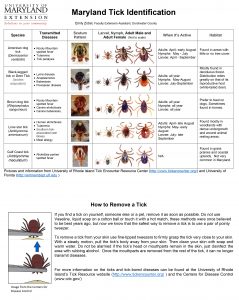Ticks go through four life cycles: egg, six-legged larva, eight-legged nymph, and adult. After hatching, a tick must eat a blood meal at each stage to advance to the next. It is typically during the larval stage that a tick becomes infected with a disease. It will then be able to spread this disease to other animals and humans throughout its life.
Once a tick has taken enough blood and is fully engorged, it drops from its host. Unlike the speedy mosquito who bites and runs, if undisturbed, a larval tick will feed for three or four days and an adult tick seven to ten days. Once satiated, it falls off, molts, and develops into its next life stage. This process repeats until the tick reaches adulthood and feeds upon a third and final host. After the adult female has fed and mated, it will find an area to lay thousands of eggs and die. This entire cycle can take up to three years, depending on the type of tick.
Tick Physical Structure
The tick mouth consists of two palps, two chelicerae, and one hypostome. When a tick bites a host, the two palps move out of the way and do not touch the host. Then the two chelicerae cut through the host’s skin with pincer-like claws, and the hypostome enters that opening. The hypostome has barbs (four rows of tooth-like structure) that face backward, making it difficult to remove the tick from the host’s skin. It’s commonly described as a “harpoon-like” structure that allows ticks to anchor themselves in place on the host.
How to Remove a Tick
It is essential to remove a tick as soon as it is discovered. The longer a tick is attached, the greater the chance it will be able to transmit a disease that it is carrying. Because of the hypostome barbs, it is challenging to remove a tick from its host. When removing a tick, make sure to grasp as close to the host’s skin as possible to ensure you remove the tick head with the body. Use tweezers to grab the tick between the skin and head of the tick and pull the tick back slowly and firmly with a straight motion. Never burn or suffocate the tick with Vaseline as this can cause it to secrete more of its saliva or regurgitate its stomach contents, both of which may carry a virus, thus facilitating disease transmission to the host.
Families of Ticks
The two main families of ticks are hard shell and soft shell. The hard-shelled tick has one blood meal per life stage and will “quest” (host seek) for its food while the soft-shelled tick can have several blood meals per life stage and usually lives in animal nests/burrows. Questing is when a tick waits at the end of a blade of grass or vegetation and extends its legs. The ability to sense a host’s breath, body odor, body heat, moisture, and vibrations from walking allows ticks to move towards vegetation near the potential host to increase its possibility of climbing aboard. The tick grabs onto a host (human, dog, deer, etc.) when it rubs against the plant on where the tick awaits.
Ticks and Temperature
Unfortunately, ticks do not die as a result of cold weather (they are more likely to die in dry, hot weather). During the winter, ticks will find shelter in foliage or an animal’s nest and remain dormant until temperatures rise. Some species will survive by burrowing in the ground or latching on to a host. Once the temperatures begin to warm up, the ticks become active and renew their questing.
Protection
To protect yourself from ticks, remove leaf litter, keep yard grass and foliage around your home trimmed, wear protective clothing and insect repellant. Make sure your pets are also taking preventative medicine. When hiking in the woods or areas with tall grass, take extra precautions.

